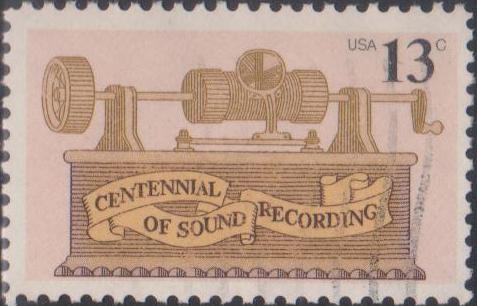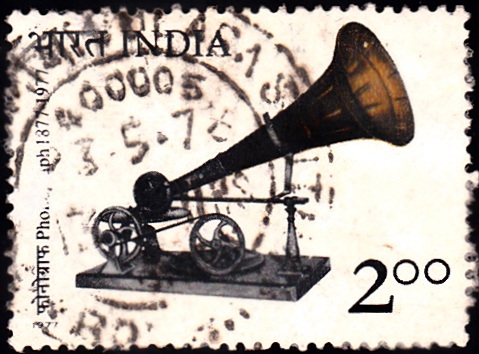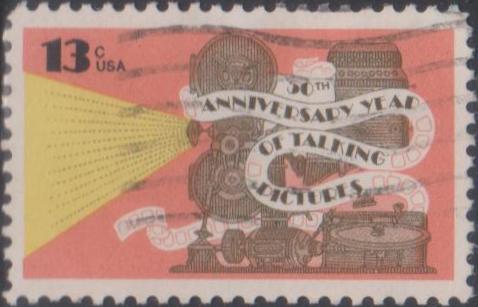
Sound Recording Centennial
A commemorative postage stamp on the Centenary of Invention of the Phonograph by Thomas Alva Edison, and Development of sophisticated Recording Industry :
 Issued by United States of America
Issued by United States of America
Issued on Mar 23, 1977
Issued for : From rudimentary mechanical grooves in hand-wrapped tin foil to high-fidelity electromagnetic tape mass-produced in quadraphonic cartridges – a century of sound recording progress, 1877-1977, is commemorated by this U.S.A. 13¢ stamp.
Design : Stamp designer Walter Einsel of Westport, Connecticut, depicted a stylized version of the original photograph, by which inventor Thomas A. Edison in 1877 heard the world’s first playback of recorded sound: his reproduced voice reciting “Mary Had a Little Lamb.” The diaphragm of this simple device concentrated the vocal vibrations into the stylus, which inscribed them on the foil around a cylinder, cranked by hand.
Type : Stamp, Postal Used
Denomination : 13 cents
About :
- During the ensuing decades, other inventors advanced the phonograph from a novelty to the magnificent electronic sound reproducing systems of today. In 1887, telephone inventor Alexander Graham Bell replaced the foil with wax, producing better sound with the Graphophone. In 1894, a German conceived the flat disc and the first record turntable, the Gramophone.
- A Camden, New Jersey, inventor added a spring-driven motor and in 1901 formed Victor Talking Machine Company, parent of RCA Victor Records. Meanwhile Bell’s work led to development of the Columbia Phonograph Company. Thus began the continuing rivalry between two record giants.
- Ten years of Western Electric Company experiments brought an exciting innovation in 1925 – electrical recording.
- The rapid rise of radio in the mid 1920’s depressed the record business, but manufacturers revived it by offering radio-phonograph combinations. Next, better plastics made fine-groove records possible, and in 1948 Columbia introduced the vinylite 33-1/3 r.p.m. disc, and RCA the 45 – better records in cost, convenience and performance than the older 78 r.p.m.’s.
- In 1958 the public thrilled to the first stereophonic records, with two channels in one groove, greatly increasing the illusion of hearing a performance “live”.
- Decades of other experiments produced sensational new recording mediums – magnetic tape and wire – providing marvelous portability plus instant erasure and re-use. Suddenly anyone could record any sound anywhere and play it back anytime.
- A century after Edison grooved his voice in tin foil, a multitude of forms of recorded entertainment and instruction were available to the world – with a quality of perfection he scarcely dreamed possible.







